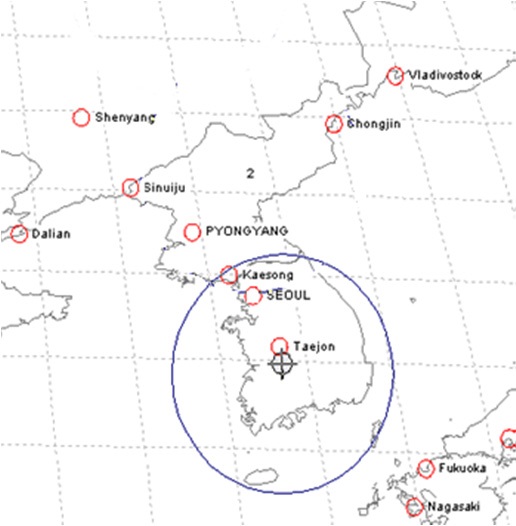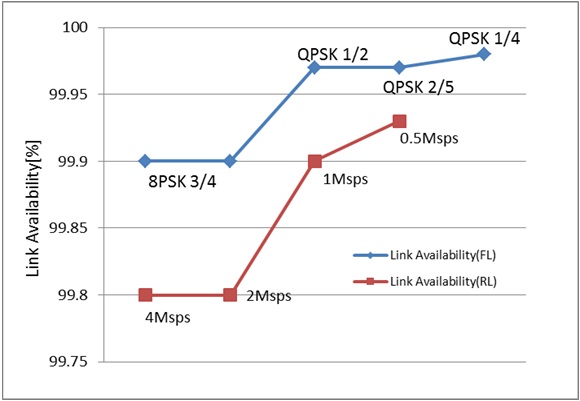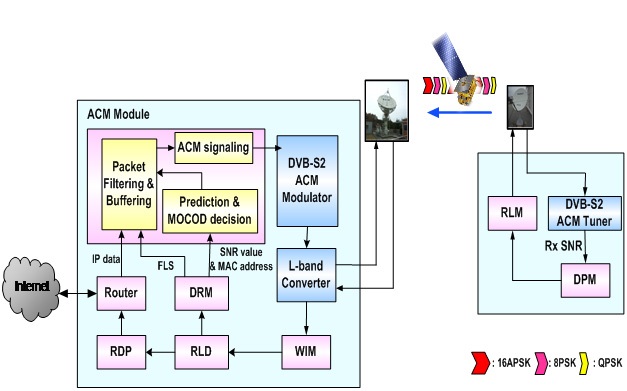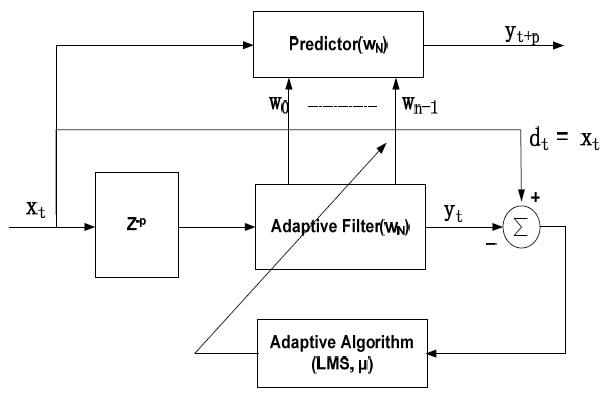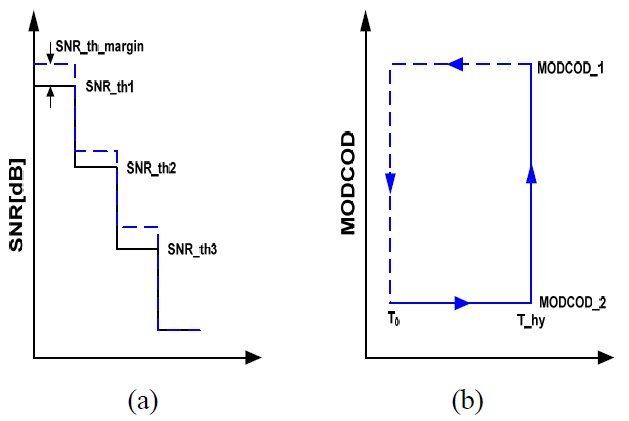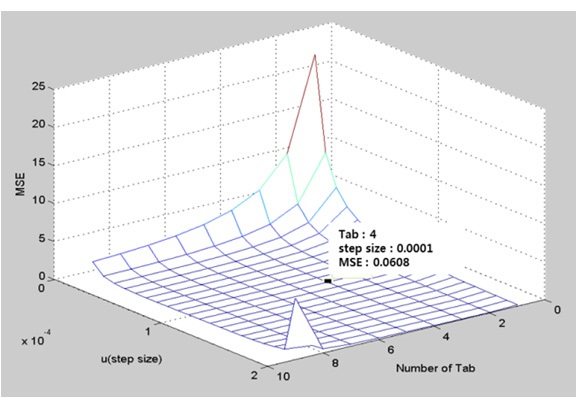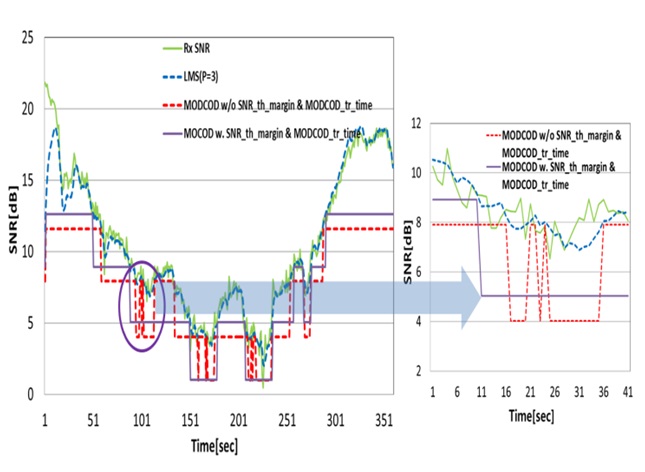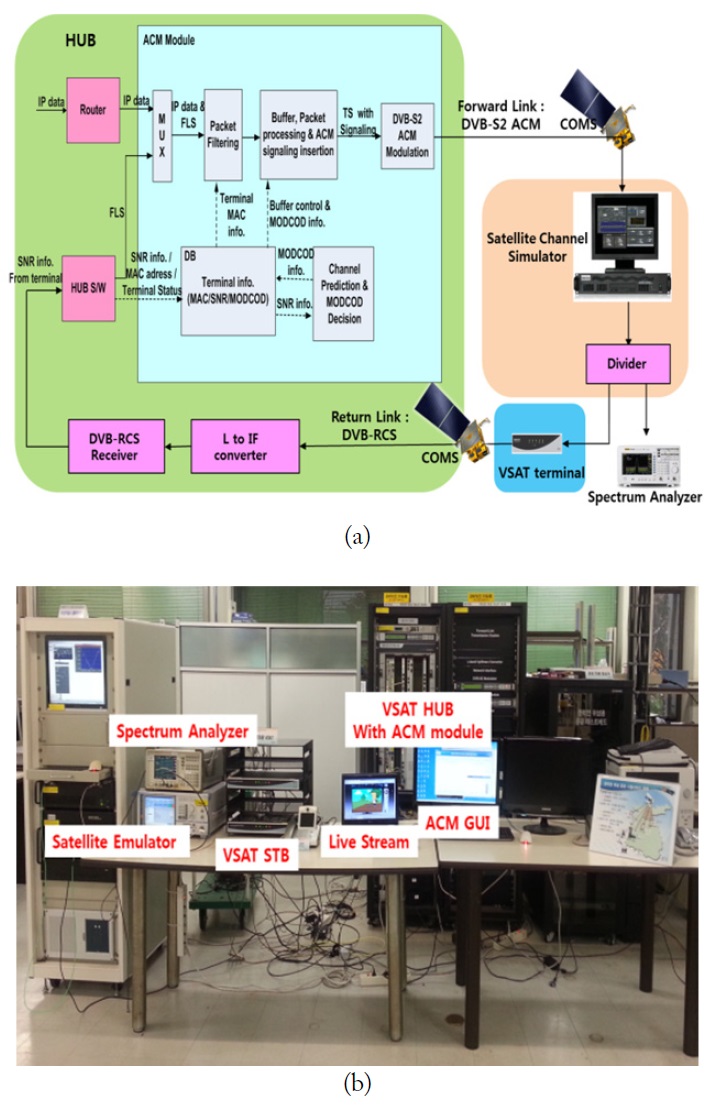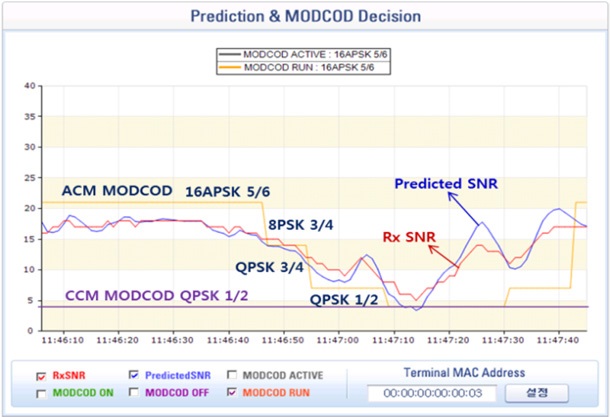



Based on the growth of Internet-based applications, the demand for high-speed satellite communication that provides a wide range of services to society, which increasingly expects ubiquitous access, is rapidly growing worldwide, similar to other wired and wireless cellular communications [1]. For this reason, future broadband satellite systems are expected to operate at higher bands, e.g., the Ka-band (20–30 GHz) because of the lack of Ku-band resources. According to this trend, the DVB has been examined as a transmission scheme for high symbolrate satellite services, similar to time slicing [2].
Although this trend will provide additional capacity to new multimedia services, the propagation impairments including rain attenuation can be greater. Thus, selecting a single physical/link design that is suited to all traffic and propagation conditions is difficult. To mitigate this problem, adaptive designs that exploit the flexibility of a system can be attractive. Using an adaptive scheme has two advantages.
First, a conventional very small aperture terminal (VSAT) system adopts a constant coding and modulation (CCM) scheme. In this case, severe rain fading in the Ka-band can cause a total loss of the link and an extremely low throughput. For this reason, the latest issue in the VSAT system is to automatically adapt the modulation type and the forward error correction (FEC) code rate based on the link condition. Its primary function is to optimize the throughput in a wireless data link by adapting the modulation order used and the FEC code rate according to the channel conditions (or other impairments) of the link. The VSAT system with an adaptive coding and modulation (ACM) function maintains the link and can yield a much higher system throughput.
Second, if satellite communication is applied to emergency communication and multimedia services, the greatest drawback is the high lease costs of the transponder. This limitation makes it difficult for a satellite communication system to compete with terrestrial service, and thus satellite operators should utilize a transponder more effectively. DVB-S2 ACM for the forward link in two-way satellite systems using DVB-RCS can be used to improve the system throughput, link availability, and bandwidth efficiency [3–5].
An ACM scheme, which is included in the second-generation DVB satellite DVB-S2 standard [3,4], implements a set of MODCOD waveforms at the physical layer. The ACM scheme is briefly described in this standard. Moreover, any VSAT manufacturer does not reveal the detailed design procedure and know-how. Therefore, this paper provides the whole procedure for developing an ACM system from link budget to evaluation.
The remainder of this paper is organized as follows. The link budget for designing an adaptive satellite communication system based on DVB-S2/RCS is introduced in Section II. In Sections III and IV, we describe the ACM system, including the channel prediction algorithm and the simulation results, respectively. The results of an implementation demonstration using a Ka-band satellite are described in Section V. Finally, the concluding remarks are presented in Section VI.
To design a satellite communication system using an ACM scheme, a link budget is performed to analyze the system link availability with regard to the system parameters, including the antenna size, satellite features, and MODCOD. The appropriate system parameters that meet the required link availability can be determined on the basis of the link budget [6].
The important points to consider when designing a satellite communication system with an ACM scheme are round-trip time (RTT) and service coverage. In a satellite communication system, the RTT and system processing delay of a satellite link take over 500 ms. In addition, the satellite communication network covers a wide area, and each terminal experiences different channel conditions. The DVB-S2 standard includes 28 kinds of MODCOD [3]. In this standard, the SNR difference between neighboring MODCODs is negligible and overlaps in certain ranges. When providing ACM services, applying every MODCOD, e.g., 32APSK, is difficult because of the nonlinearity of HPA and the phase–noise problem. The fade rate in the Ka-band is at around 3–5 dB/s, whereas the fade rate in the Ku-band is approximately 1 dB/s [7]. The frequent transition of MODCOD can degrade the BER performance in the Ka-band because of the long RTT and high fade rate.
Therefore, the appropriate number of MODCODs should be selected to reduce the transition frequency of MODCOD. The appropriate MODCOD is chosen on the basis of the link budget. To calculate the link budget, the ground system and satellite transponder parameters are required. Table 1 shows the ground system parameters for the link budget.
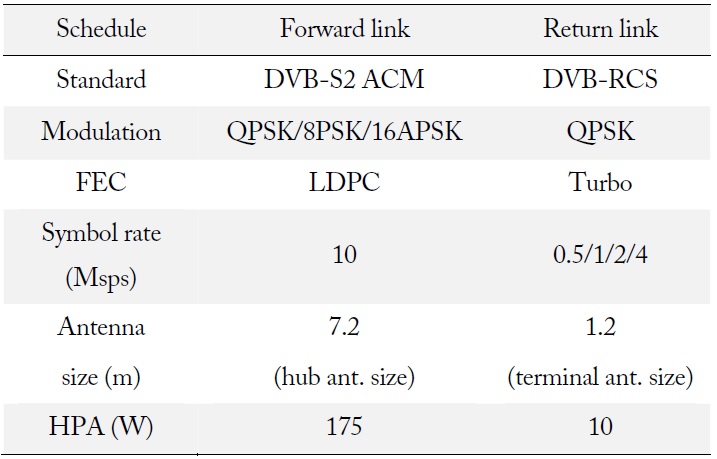
System parameters
In this paper, the Communication, Ocean, and Meteorological Satellite (COMS), which is the Ka-band satellite, was used as the target satellite. COMS was launched on June 26, 2010 and reached an operational geo-stationary orbit of 128.2oE. As a hybrid satellite, COMS consists of communication, ocean, and meteorological payloads. The major missions of COMS are weather monitoring, ocean monitoring, and broadband satellite communication. The main features of COMS are summarized in Table 2. As shown in Fig. 1, the service coverage of COMS is the Korean peninsula [8]. Fig. 2 illustrates the link budget result using these parameters.
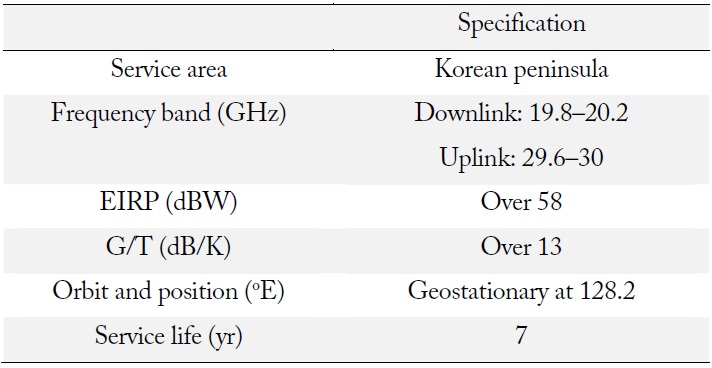
Features of COMS
As indicated in Fig. 2, the link availability of the forward link is 99.98%, but that of the return link is 99.93%. Therefore, the lowest MODCOD of the forward link in this system is QPSK LDPC 1/2 because the maximum link availability of the return link is 99.93% at QPSK Turbo 1/2. To avoid frequent transitions of MODCOD, the appropriate SNR difference of each MODCOD is about 3 dB. The chosen MODCODs are as follows: 16APSK LDPC 5/6, 8PSK LDPC 3/4, QPSK LDPC 3/4, and QPSK LDPC 1/2 [9].
III. SATELLITE FORWARD LINK ACM SYSTEM
As illustrated in Fig. 3, the architecture of a satellite communication system is composed of a hub and a terminal. The transmission part of the hub consists of a router, a DVB-S2 ACM modulator, and an ACM module. The receiving part of the hub consists of an Rx data processor and a return link demodulator. To implement the ACM scheme, the terminal should measure the signal quality of the forward link signal and send it back to the hub every second. Using this information, the ACM module in the hub predicts the future channel condition and determines the proper MODCOD of each terminal. The hub then transmits useful data using the designated MODCOD. Regardless of the channel condition, the forward-link signaling information should be allocated to the robust MODCOD to maintain synchronization.
To transmit the forward-link signal using DVB-S2, IP packets are transformed into digital storage medium-command and control private section packets. These packets are sequentially converted into MPEG2-TS packets. An IP gateway usually performs this function. In a satellite communication system with an ACM function, the ACM module includes this processing [10].
Fig. 4 shows a block diagram of an ACM module, which consists of a database block, packet-filtering block, channelprediction and MODCOD decision block, buffer block, packet-processing block, and ACM signaling-insertion block. The required functions of an ACM module are briefly summarized as follows:
An efficient prediction scheme consists of two functions: discrete-time low-pass filtering and rain-fade prediction. To implement adaptive rain fade compensation according to the channel conditions, predicting the channel quality accurately in advance with consideration of the round-trip delay is necessary. The SNR variation in a satellite link includes a variation of the rain attenuation and a comparatively fast scintillation. The prediction scheme needs to filter out this fast variation because the SNR variation from scintillation is much faster than the response speed of an adaptive system.
In this paper, a simple recursive filter is used for filtering the fast variation of SNR, which can be expressed by (1), where
where 0 <
To predict the future SNR, the least mean square (LMS) adaptive filter is used. This prediction algorithm adopts variable weights using adaptive filtering prediction (AFP) as shown in Fig. 5 [11] and expressed by (2). The LMS algorithm adaptively minimizes the error between the predicted and received SNR values. The weights of the adaptive filter are updated every second.
where
In the case in which MODCOD is chosen, choosing a lower MODCOD than required is safe. However doing so may reduce the spectral efficiency. Moreover, a higher MODCOD with a small fade margin is selected for ACM operation. This MODCOD can conserve satellite capacity, but the probability of a successful packet transmission can be decreased. Therefore, the MODCOD decision algorithm should be applied. In this paper, four kinds of MODCOD, i.e., 16APSK LDPC 5/6, 8PSK LDPC 3/4, QPSK LDPC 3/4, and QPSK LDPC 1/2, are used for the ACM scheme.
As shown in Fig. 6(a), the SNR threshold margin is applied to avoid frequent MODCOD changes, which will occur when the observed SNR is near a threshold. In case this algorithm is not applied and the SNR level varies abruptly, the ACM module may frequently switch MODCODs to maintain the satellite link satisfying the required BER. As shown in Fig. 6(b), the algorithm uses a holding timer to adapt the channel variation. It enables switching to change the MODCOD to a higher level only if the MODCOD is continuously selected during a predefined period.
The channel prediction performance using the AFP of the ACM scheme is simulated. The MODCOD decision result shows if a MODCOD decision algorithm is applied. To simulate the SNR prediction and MODCOD decision in a real environment, the rain attenuation values, measured using a rain attenuation measurement system (RAMS) [12] through the COMS, are used.
1. Channel Prediction Simulation
The mean square error of the AFP based on LMS should be minimized to obtain the optimal channel predictor. Therefore, simulation is performed to obtain the minimum mean square error (MMSE), while step size (μ) and the number of filter taps vary. As illustrated in Fig. 7, the MMSE of the channel predictor is 0.0608 when step size (μ) and the number of filter taps are 0.0001 and 4, respectively.
Fig. 8 shows the MODCOD decision result before and after MODCOD decision algorithm is applied. The dotted red line is the selected MODCOD without algorithm, and the purple line is the selected MODCOD with algorithm. Part of the simulation results is enlarged to observe how well the MODCOD decision algorithm works. Before the MODCOD decision algorithm is applied, frequent MODCOD transitions occur, and these transitions can worsen the satellite link. A satellite communication system cannot adopt the system parameter quickly because the round trip delay is over 500 ms. As illustrated in Fig. 8, the unnecessary MODCOD transitions are diminished after applying the algorithm. In this simulation, the holding time to prevent the frequent transitions of MODCOD is set to 3 seconds. After installing the ACM system, this value should be updated through trial and error.
V. DEVELOPMENT AND DEMONSTRATION OF THE SATELLITE FORWARD LINK ACM SYSTEM
A rack-mounted prototype PC platform, which includes a commercial DVB-ASI PCI card, is used as an ACM module. To verify the performance of the ACM module, a testbed of the satellite communication system with ACM using COMS is established. Fig. 9(a) shows the testbed configuration, and Fig. 9(b) presents the integrated testbed in a laboratory. The testbed consists of a satellite channel emulator, a HUB including an ACM module, a VSAT terminal, and a spectrum analyzer. The satellite channel simulator emulates the rain fading environment, and the VSAT terminal sends the SNR information every second.
For the ACM function test, the VSAT terminal accesses the website of a commercial broadcaster through the satellite link and receives a real-time video stream under a rain-fading channel condition.
Fig. 10 illustrates the test results of the ACM system. As shown Fig. 10, a predicted SNR with blue line predicts the received SNR with red line. Using this result, the measured average prediction error of the ACM system, i.e., the value of 0.28 dB, is calculated. The VSAT terminal operates well without discontinuity while receiving a live stream.
In this paper, a satellite communication system with an ACM module is introduced. To predict channel fading impairments, the adaptive filter predictor based on LMS is devised. Furthermore, a MODCOD decision algorithm that consists of an SNR threshold margin and a MODCOD hold time is applied to prevent frequent MODCOD transitions. An ACM module is designed and implemented on the basis of a prototype rack-mounted PC to provide channel adaptive service.
The performance of the proposed method is verified by a demonstration in real time using the COMS, which is a Kaband satellite. The measured average predicted error in the demonstration is 0.28 dB, which indicates that ACM can remarkably improve the system link availability and throughput.


